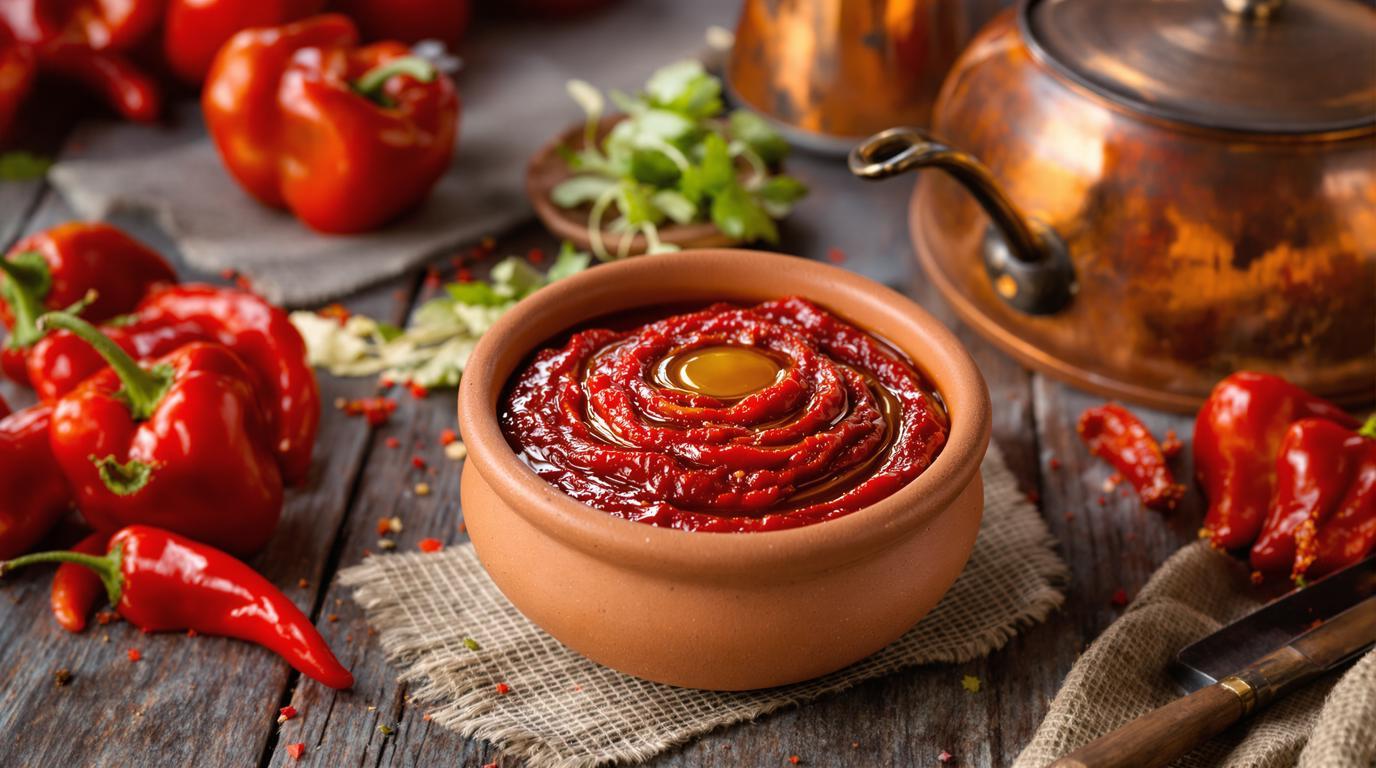There’s something deeply satisfying about making a dish that has been passed down through generations. Growing up, my grandmother’s spice cabinet was a treasure chest of flavors, but nothing commanded more respect than her prized cayenne pepper. “This isn’t just heat, Alexander,” she’d tell me with a knowing smile, “it’s the soul of the dish.” That wisdom stayed with me throughout culinary school and my professional career. Today, I’m sharing my grandmother’s Armenian red pepper paste—a condiment so versatile and flavorful that it has earned a permanent place in my kitchen. Unlike commercial versions, this homemade paste captures both the sweetness of ripe peppers and the gentle warmth of cayenne in perfect harmony.
The Story Behind Armenian Red Pepper Paste 📖
This paste (also known as “biber salçası” in neighboring Turkey) has been a cornerstone of Armenian cooking for centuries. While traveling through mountain villages outside Yerevan, I discovered that almost every family had their own closely guarded version. Traditionally prepared in late September when peppers reach peak ripeness, this paste was originally developed as a preservation method before refrigeration. Families would gather for days, processing bushels of peppers to create enough paste to last through winter. The variations I encountered—some fiery hot, others more sweet—reflected each family’s unique preferences and regional influences.
Essential Ingredients 🧾
For this smaller batch (traditional recipes often used bushels):
- 4-5 large red bell peppers (about 2 lbs/900g)
- 1-2 teaspoons kosher salt (adjust to taste)
- ½-1 teaspoon cayenne pepper (optional for extra heat)
- 1-2 tablespoons olive oil (optional, for preservation)
Chef’s Note: The quality of your peppers matters tremendously here. Look for deeply red, heavy peppers with tight, glossy skin. If you can find them, red Shepherds or Carmen peppers offer an even sweeter flavor profile than standard bells. Much like in Nonna’s 2-hour tomato sauce, the natural sweetness of perfectly ripe produce creates depth without added sugar.
Step-by-Step Instructions 📝
1. Prepare the peppers: Wash peppers thoroughly. Remove stems, seeds, and white membranes. Cut into quarters.
2. Process the peppers: Traditional methods call for a hand grinder, but a food processor works well for smaller batches. Pulse until you achieve a coarse consistency—you want texture, not a smooth puree.
3. Season carefully: Transfer the processed peppers to a heavy-bottomed pot. Add salt gradually, starting with 1 teaspoon. If using cayenne, add it now, starting with ¼ teaspoon and adjusting to taste.
4. Cook slowly: Bring the mixture to a gentle simmer over medium-low heat. Reduce heat to low and cook uncovered for 1-2 hours, stirring occasionally to prevent sticking. The paste is ready when it’s reduced by about half and no liquid pools on the surface.
5. Cool and store: Allow to cool completely. Transfer to sterilized jars and cover with a thin layer of olive oil if storing longer than a week. Refrigerated, it keeps for about 3 weeks; frozen, up to 6 months.
Chef’s Secret Techniques 🤫
The real magic of this paste lies in the slow reduction. As moisture evaporates, the natural sugars in the peppers concentrate and caramelize slightly, creating complex flavors that simply can’t be rushed. While traditional Armenian grandmothers might insist on strictly manual grinding, I’ve found that brief pulses in a food processor, followed by patient, low-heat cooking, yields authentic results that honor tradition while fitting into modern kitchens.
For a smoky variation that complements dishes like those in these game-changing egg recipes, char one of the peppers directly over a gas flame before processing with the raw peppers.
Serving & Presentation Tips 🍽️
This versatile paste shines in so many applications:
- Stir a teaspoon into yogurt for a vibrant dip that pairs beautifully with Scottish Grandma’s silky porridge for a savory breakfast
- Spread thinly on flatbread before topping with cheese and herbs
- Add a tablespoon to marinades for chicken or lamb
- Stir into soups and stews for depth and color
- Mix with a splash of homemade apple vinegar and olive oil for an instant salad dressing
I’ve seen home cooks transform simple dishes into memorable meals with just a teaspoon of this magical paste. It’s particularly divine when paired with rich chocolate desserts like this 5-ingredient French chocolate cake—the subtle heat creates a beautiful contrast to the sweetness.
Remember, cooking is about connecting to our roots while making traditions our own. This red pepper paste carries centuries of wisdom in its vibrant color and complex flavor. Whether you follow this recipe exactly or adjust it to your family’s preference, you’re participating in a beautiful culinary tradition that spans generations. From my grandmother’s kitchen to yours, enjoy the journey.
